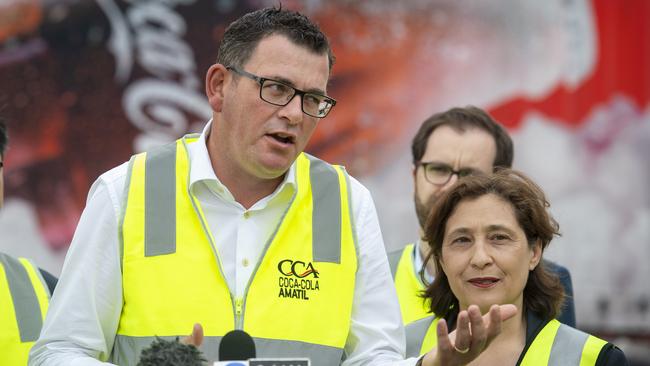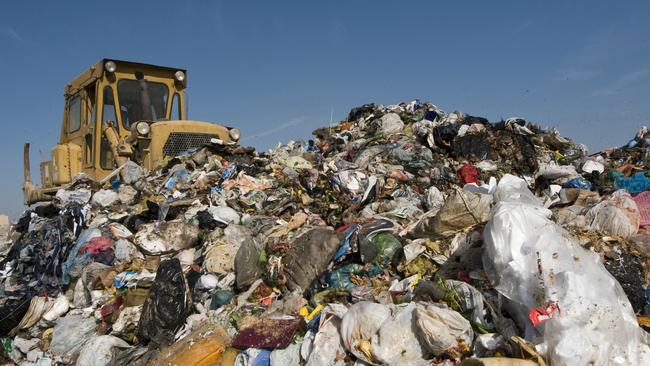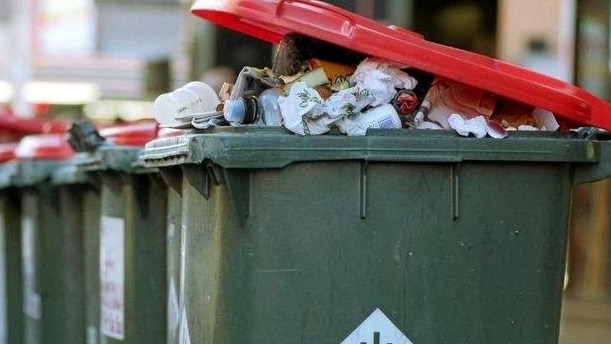Environment Minister Lily D’Ambrosio announces plans to almost double landfill levy
Victoria’s landfill levy is set for a massive increase in a shock tax hit unveiled by the Andrews Government as part of its recycling overhaul. Find out how much you will pay.
VIC News
Don't miss out on the headlines from VIC News. Followed categories will be added to My News.
Ratepayers are set to be slugged with higher waste charges as Victoria’s tip tax is almost doubled over the next three years.
The tax hike — described as a “bitter pill to swallow” by business groups — is the latest plank of the Andrews Government’s recycling reforms, including a container deposit scheme and a four-bin kerbside collection system.
But senior Labor MP Cesar Melhem has broken ranks, saying the government’s target to divert 80 per cent of waste from landfill by 2030 did not go far enough.
“I don’t want to see the Ravenhall tip continue to operate for the next 50 years because we’re building houses all around it,” the Western Metropolitan MP told the Herald Sun.
“We’re not really biting the bullet and basically seeing an end of residual waste going to landfill … I will continue that crusade.”

Environment Minister Lily D’Ambrosio revealed the landfill levy — currently $65.90 per tonne — would be jacked up $20 a year for three years to match other states and stop Victoria being used as a waste dumping ground.
The move will likely reap hundreds of millions of dollars in extra revenue but the government was unable to say how much, as it aims to reduce the amount of waste taken to landfill.
The levy is mostly paid by councils on kerbside collections, as well as businesses and households dropping off rubbish attips.
The Australian Industry Group’s Victorian head Tim Piper called on the government to ensure any extra revenue was reinvested, adding ratepayers would bear the brunt of the increase.
“They will see it when they pay their rates because councils are not going to wear these costs,” Mr Piper said.
Municipal Association of Victoria deputy president Ruth Gstrein said the levy was “an important tool” in changing behaviours on waste.
“An increase in the landfill levy isn’t unexpected. We must make sure that Victoria isn’t a dumping ground for waste from interstate simply because it’s cheaper,” she said.
“Our primary concern is that the money raised through the levy is invested back into the resource recovery system to support circular economy outcomes.”
Ms D’Ambrosio said the government’s $300 million waste reform plan would “revolutionise household recycling, drive business innovation and create jobs of the future”.
The government backed waste-to-energy technology — used around the world to divert rubbish from landfill and convert it into power — but with a cap of one million tonnes a year until 2040.

Mr Melhem, who chaired the parliamentary inquiry into recycling and waste, said the overall policy was “excellent” but the waste-to-energy cap was “sending the wrong signal”.
“You can’t be half-pregnant — it’s time to get this done,” he said.
“I’m not pleased with this and will continue campaigning to change the policy.”
A $600 million facility proposed by Australian Paper to power its Maryvale mill would use 650,000 tonnes a year.
Ms D’Ambrosio said the levy needed to be increased.
“It will still be less than the levy in New South Wales and South Australia,” she said.
“This is about providing incentives to industry to keep waste out of the landfill and turn them into productive materials.”
But Mr Piper said: “This is a 100 per cent increase in just over two years.”
“The cost will increase for consumers, for businesses and even recyclers,” he said.
Ms D’Ambrosio said the change was part of the government’s plan to reduce waste going to landfill by 80 per cent over the next decade.
“There may be some costs involved in that and I am not here to say there will be,” Ms D’Ambrosio said.
“This is not an easy thing to fix.”

Ms D’Ambrosio said questions of cost were a matter for Treasurer Tim Pallas.
The landfill levy has been raising about $215 million a year — compared to $48 million a decade ago.
The parliamentary committee report into the state’s recycling industry, completed late last year, found Victoria had the lowest landfill levy of all mainland states, which was “acting as an incentive for waste to be transported to Victoria from states with a higher rate”.
It called for the landfill levy to be increased “to the extent that the financial incentive to transport waste materials from other jurisdictions, as well as the incentive to send material to landfill, is removed”.
The levy is currently $143.60 per tonne in metropolitan areas of New South Wales and $82.70 per tonne in regional areas. It was only introduced in Queensland last year, at $70 per tonne.
Shadow Treasurer Louise Staley raised concerns the levy increase would be used to prop up the budget and said it would impact ratepayers.
“Every Victorian household will pay this,” she said.
“They will either pay it directly with a new charge on their rates bill or whenever they turn up to pay at the tip.”
She also warned increasing the levy may lead to rogue dumpers illegally disposing of material.
MORE NEWS
